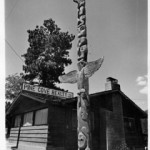By Kate Kramer
Special to the Town Crier
Last month I gave a presentation about the Idyllwild Lemon Lily Festival at the state meeting for the California Native Plant Society in San Jose. Native plant lovers from across California were a receptive audience for the story of the festival and the local efforts in conserving and restoring the Lemon Lily.
We were assigned a time slot in the “conservation negotiations” session and asked to emphasize the process of how people worked together. After a flurry of emails from Dave Stith, my co-author on the talk, and others, I attempted to put the history of how the Lemon Lily Festival in Idyllwild came to be. This report is happily supplied to the Town Crier. With the photos, I was able to show members of the California Native Plant Society exactly what the festival looked like (and how much fun it is).
The place to start, of course, is with the Lemon Lily. Most “native plant people” are familiar with native lilies, but not with our Southern California Lemon Lily. As this meeting took place in Northern California, some background was in order.
Lilium parryi is a beautiful yellow lily that grows along high-elevation creeks and streams, and wet meadows from a small bulb-like rhizome. The Lemon Lily is mainly restricted to the mountains of Southern California with a few populations known from the mountains of Southeastern Arizona.
This winsome lily can produce multiple 6-inch showy yellow flowers per plant in a season, and, is very easy to fall in love with. It was once very common in the creeks and meadows of the San Jacinto Mountains (and probably in the San Gabriels and San Bernardinos, too). Older visitors attending the festival have even shared memories of seeing it in some of the creeks around Idyllwild.
We have reason to believe it was much more common from a single observation made by Harvey Monroe Hall, the first botanist to do a flora survey of the San Jacintos in 1902. On one day, a single bulb collector removed more than 5,000 bulbs from the Idyllwild area. Bulb collecting was quite common in those days as hobby gardeners from the turn of the last century were keenly interested in new garden plants.
Between the bulb poaching and continuing drought conditions, Lemon Lilies have become rare. Only those who can venture into the high country really have the chance to see them.
Next I explained and described Idyllwild — a small community without a single ski-lift or large, recreational lake. Our area attracts artists, nature lovers, rock-climbers and Pacific Crest Trail hikers. Families from all over Southern California visit Idyllwild, especially on summer weekends to escape the heat. People live and visit here because they like nature.
An important part of the history of the current interest in Lemon Lilies comes from a loosely organized group of rather serious amateur botanists, key among them, our own Stith, who started hiking and learning about plants from Tom Chester. As an energetic amateur botanist, Chester has made plant lists for many of the local trails in San Diego and Riverside County.
Chester is the one who brought the observations of Harvey Monroe Hall to our attention about the massive bulb poaching that happened earlier in the last century. Stith and Chester set out to survey and count the Lemon Lily plants on Forest Service and State Park lands.
Stith has been tracking one area, Candy’s Creek, for at least five years now. He and I were talking one day when I made a completely off-the-cuff remark that “we ought to have a Lemon Lily festival” so that more people would know about them and want to protect them. Stith ran with this idea, and you know the rest is history.
So, how did this festival of five years running actually start? With the dedicated efforts of an original committee of five people — Stith, Shelley Kibby of the Idyllwild Nature Center, Harold Voorhees of the Garden Club, Denise Huntington of the Friends of the San Jacinto Mountain County Parks and Doug Yagaloff, representing the town merchants.
It took many meetings to plan the first festival, and various people cycled through the committee. It was often hard to keep everyone going the same direction and to decide on which ideas to use, but in the end it was a dedicated group of people with a common goal that pulled it off.
Since the talk was in a “negotiations” session, I mentioned some of the challenges, such as turnover of leadership (losing Yagaloff), merchants less involved, results from restoration efforts taking time and planning an event around a blooming plant.
The aspects we have going for the festival are a small, nature-loving community, a consistent supportive institution (the Nature Center), a wonderfully charismatic species and sustained conservation interest from the community.
It was easy to describe the festival (and great to have the photos). I related how popular it has been, with booths of information, special T-shirts, the quilt raffle, the banner contest, the theme of the turn-of the century activities for kids, the Penny-Royal Players, the art show, the hikes, the Lemon Lily and general natural history information talks, and especially, the “Lemon Lily Song.” I finished the talk with the clip of the Huel Howser episode of the Lemon Lily Singers in action. That conveyed the love and the fun that has made the festival what it is.
People have been coming up to me since the talk and saying how much they would like to come this year. The 2015 festival is set for July 11 to12, so watch for more information and be part of the fun.
Kate Kramer is a U.S. Forest Service botanist.










